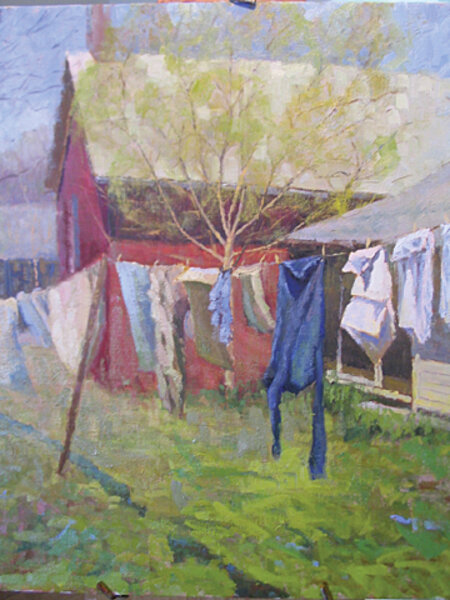Awash in art
Loading...
Our single-story brick home, with its simple lines and canopy of trees, is not a standout among the eminently paintable subjects in our historic community on the Wabash River in southern Indiana.
For a few days in early spring, artists from around the region gather in New Harmony to set up easels on street corners, in parks, along the riverfront, or wherever else the light, colors, and scenery beckon. The "First Brush of Spring Plein Air Paint Out" is a favorite event of mine, and of many here. The artists gravitate toward the town's Victorian mansions, or the log houses, wattle and daub constructions, and brick dormitories erected by the early 19th-century Harmonists, a religious sect from Germany that established the town as a pioneer utopia.
Some set up by fountains, labyrinths, sculpture parks, and the town's iconic roofless church, all set off by profusions of flowers. A huge stone granary dominates one block, 19th-century geologist David Dale Owen's cupolaed laboratory (modeled after the Smithsonian Institution) pokes prettily over a garden wall on Church Street, and the quaint, low-spiking skyline of the Victorian downtown begs to be painted. Two structures much in favor this year were a little green footbridge crossing the pond behind the inn, where graceful white swans posed shamelessly, and the lovely old humped bridge linking Indiana to Illinois over the broad back of the Wabash, which seemed all the more poignant on canvas for its having been recently barricaded to traffic and its likely permanent fade into transportation history.
Not that we've been wholly ignored. Several years back an artist paused as she walked along the alley bordering our backyard, her attention caught by something moving in the breeze. Venturing closer she found Charlie slumbering in a lawn chair. He'd just bicycled the 150 miles between our farm near Bloomington and our second, New Harmony, home.
After arriving, he'd washed and hung his faded blue shirt and other well-worn clothes, handkerchiefs, and backpack haphazardly on the rope line, then had sunk to rest in the sun as it and the breeze dried his togs.
She left him to his repose, but after a while returned and, finding him awake and the clothes still hanging, asked if she could set up her easel and get to work with her oils.
April Knox's "Charlie's Laundry" is hardly representative of the town's history and distinctions or likely to lure tourists. But her well-composed depiction of our "plein air clothes dryer," strung post to post over a walking path through the unmowed spring grass delighted us. The back corner of our home, its screened-in porch, and the sun-dappled shade of a young mulberry tree furnish a quiet backdrop.
We could not afford to purchase it at the time, but we struck up a friendship with April and kept in touch. As for the painting, it sold years ago, from a gallery in Fort Wayne, Ind.
Happily, we have its reproduction, which was printed on the cover of the brochure announcing the following year's "Plein Air Paint Out" event. Charlie tacked it up in the backyard workshop where we both gaze at it now and then. Our other option on a fine warm day is to run a wash, hang it out, and pull up a couple of lawn chairs to watch a fresh "canvas" of a little-noticed New Harmony scene dry before our eyes.





